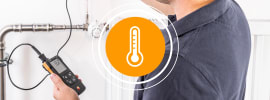Self-explanatory menu guidance makes operation simpler and makes your job easier. Thanks to the high resolution colour display, the readings are easy to read off even when the light is poor. The flue gas analyzer can store up to 20 measurement protocols. It is possible to export the measurement protocols in Excel optionally via mini-USB.
Quality that you can depend on: the testo 320 basic flue gas analyzer is TÜV-tested according to EN 50379, Part 1-3 and to 1st German Federal Immission Control Ordinance (BImSchV), Part 1-2. When you purchase the flue gas analyzer, you get a 2-year warranty (for the instrument, probe, O2/CO sensor).
testo 320 basic flue gas analyzer: compact and powerful
- Flue gas analysis on heating systems: the testo 320 basic flue gas analyzer is equipped with two sensors – an O2 and a CO sensor (without H2 compensation). In the case of CO measurement, the measuring range goes up to 4,000 ppm. You need a flue gas probe for the flue gas measurement (can be ordered separately). A temperature probe is integrated into the probe. All relevant flue gas measurement parameters can therefore be calculated: CO2 value, efficiency and flue gas loss. The flue gas analyzer is also suitable for flue draught measurements or pressure measurements
- Changing probes is easy: The probes can be changed by the user. This means you can order other probes specifically required for your flue gas analysis (e.g. multi-hole probe, dual wall clearance probe, flexible flue gas probe)
- Single-hose connection: in just one hand movement, all channels for the flue gas measurement can be securely connected via the probe coupling (gas paths, draught, temperature probe integrated in the flue gas probe, which can be ordered separately)
- Long service life thanks to the long-life Li-ion rechargeable battery
- Built-in magnets enable the flue gas analyzer to be attached to the burner/boiler quickly and easily
- Integrated condensate trap: easy to empty
Fields of application for the testo 320 basic flue gas analyzer
- Flue gas measurement (focus on gas: combustion air temperature, flue gas temperature, O2, CO and CO2 concentration, flue gas loss, gas/air ratio, efficiency)
- Gas flow and gas resting pressure (with optional hose connection set)
- Differential temperature measurement to determine the spread between flow and return (with optional differential temperature set)

































